An organization turning 100 years old isn’t so unusual in civic-minded San Pedro. But being a vibrant 100-year-old entity with more than a pulse is something else.
There’s a small Reform synagogue here that continues to make gentle waves with its commitment to relationships and DEIA (diversity, equity, inclusion, and accessibility). Temple Beth El San Pedro celebrates its 100th anniversary this month. To be doing so in a town primarily built by Croatian and Italian Catholics makes this fact more remarkable. Add to this that a group of women initiated the major push to establish this synagogue at a time when women were finally guaranteed the right to vote. Today, with its progressive mindset remarkably intact, this “oldster” has a female rabbi, Cassi Kail.
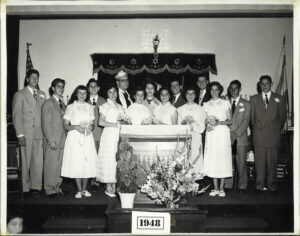
The Temple’s Confirmation class of 1948. (photo: courtesy Temple Beth El)
Temple Beth El’s vitality is rooted in creative assessment and an abiding love of community. With their genuineness comes a deep intent to welcome everyone, to be a congregation of color.
“It’s building upon the temple’s value of creating a warm and welcoming place where everyone of all different backgrounds can belong,” says Rabbi Kail. “People think of Jews as being white with European roots. And that’s not the case. There’s huge, huge diversity within the Jewish population.”
Back in 1922, there wasn’t a sizeable Jewish population in San Pedro. A group of about 25 Jewish families began to find one another. In September 1922, these families celebrated their first High Holy Days in someone’s living room. Soon after, several women started raising money to bring in a Torah scroll and eventually established a meeting place at the Odd Fellows Temple at 10th and Gaffey. The congregation moved to its current location on 7th Street in the 1950s. With its roughly 250 families, Temple Beth El’s congregants hail from San Pedro, Palos Verdes, Rolling Hills, Torrance, Long Beach, and beyond.
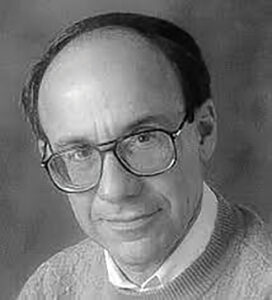
Rabbi David S. Lieb was TBE’s spiritual leader from 1971-2006. (photo: courtesy Temple Beth El)
Rabbi David Lieb led the congregation for more than three decades. “His love of Jewish people, his love of people, of scholarship, of Torah, really helped the congregation to become a community of people who show up for one another and who really want to enrich their lives with the wisdom of Jewish rituals and Jewish teachings,” says Rabbi Kail. “Following him, there was Rabbi Chuck Briskin, who was very involved in the greater community and social action. And he really tried to find ways to put our faith into action and forge partnerships to help people in our community struggling with homelessness.”
Temple Beth El continues to nurture these partnerships with an interfaith Episcopal community in San Pedro. “I have some of the most incredible interfaith partners in San Pedro. I truly feel blessed every day to be able to work with them,” says Rabbi Kail. “Pastor Lisa Williams, who is a rock star at San Pedro United Methodist Church, really has been leading the effort in terms of helping families who are unhoused and who are on the verge of complete poverty. We work with her on that. We work with the Garden Church and Reverend Amanda Riley on several different programs. Jeanette Repp at St. Peter’s Episcopal Church did an incredible fundraiser for the people in Ukraine, and we partnered with her on that. We had a presence at the Pride Parade. I’m working with some faith partners on an incredible project called Harbor Connects, which is providing small grants to people in our community who are on the verge of real financial distress and giving them enough money to take care of a need so that they don’t end up on the streets.”
Cantor Ilan Davidson has been with Temple Beth El for 28 years. Besides his work inside the synagogue, he definitely “takes it out into the community.” The energetic cantor was the past president of the South Coast Interfaith Council and is the current president of the Los Angeles County Commission on Human Relations.
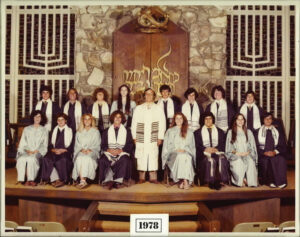
Temple Beth El’s Confirmation class of 1978. (photo: courtesy Temple Beth El)
Judaism is the only faith that has a dual clergy: the rabbi and the cantor. “The cantor’s primary work is through the liturgy,” says Cantor Davidson. “It’s the cantor whose expertise is to know how the melodic nature that we pray changes based upon time of year, time of day, whatever the case may be. Because all of our prayers in Judaism are primarily sung and chanted, it’s the cantor’s job to really be the leader of prayer, to teach in that nature.”
“Our community loves to sing, and I encourage them to,” he continues. “This is a very prayerful congregation. They love to pray along and not just be spectators and listeners but be active participants.”
“Yes, I’m an ordained rabbi that people can go to, and I can hopefully inspire and move people and teach people,” says Rabbi Kail. “But it’s not just me. Every member of our community has incredible wisdom. And they have their own piece of Torah to impart. And so it’s very much within the reformed model and the Temple Beth El model to help people highlight their own wisdom within and to help one another through the ups and downs of life.”
Temple Beth El experienced even greater unity and expansion when the pandemic hit. “We had absolutely no delay. We upgraded every type of service and the capability to go immediately virtual,” says Carrie Jacobs, Temple Beth El’s executive director.
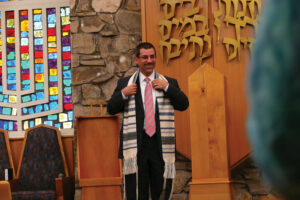
Rabbi Charles K. Briskin led TBE from 2006-2018. (photo: courtesy Temple Beth El)
“We created more opportunities for people than we thought possible,” says Rabbi Kail. “I was running a short morning service every day, and people would show up at 8:30 in the morning to be a part of it every day. We had online concerts, which we keep to this day, that go on once a month but were every week during the pandemic. Really anything we could think of to bring the community together. And this allowed people to really get to know others they hadn’t connected to before. Suddenly, everything was available for them at the touch of a button on their computer. People were able to participate more. I think it brought our communities so much closer together.”
“I just celebrated my 10th year in this position. But I’m a born-and-raised-at-Temple-Beth-El girl. My family have been members here for over 40 years,” says Jacobs. “This is literally like home and family for me. You’ll be welcomed. We have a social hour after our services called Oneg Shabbat, and you’ll never be sitting alone. It’s a different feeling here than you would get anywhere else.”
“For me, it was just an immediate connection, and people were just so warm and down-to-earth and friendly and supportive,” says Temple Beth El board president Tom Rosenberg. “It’s been a great thing for our family.”
The tag team at Temple Beth El is very small and extremely tireless. “They’re like heroes to me,” says Rosenberg. “They do amazing amounts of work and wear different hats.”
The clergy team consists of the rabbi, cantor, and a part-time educator. The administrative staff is a whopping two people: Jacobs and a finance coordinator. They take care of everything that has to do with temple life, like the facilities, the programming, and communications.
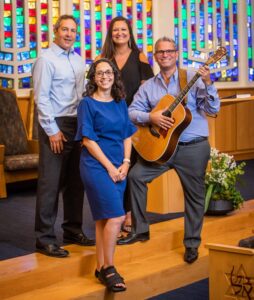
Temple Beth El’s current leadership: Board President Tom Rosenberg, Rabbi Cassi Kail, Executive Director Carrie Jacobs, and Cantor Ilan Davidson. (photo: John Mattera Photography)
There is also a 16-member board of directors, which includes Rosenberg and five vice presidents who lead various departments, like education, operations, engagement and outreach, and finance.
“You know, what strikes me, just being on boards before and other philanthropic organizations and community organizations, it’s the proactiveness, the thoughtfulness, the preparation, and the willingness to execute these things,” says Rosenberg.
Shabbat services start at sundown on Friday nights. Again, they’re multi-access, meaning in-person or virtual. “Our Saturday morning Shabbat services are different every week. We try to offer a range of opportunities,” says Jacobs.
“Once a month, we have a healing service for a Shabbat Saturday morning. Another Saturday morning, it’s a Shabbat meditation service. Also, Rabbi Cassi leads an off-site service called Torah on the Trails, where you’re walking in beautiful parts of our community and celebrating Shabbat outside in nature. A couple of times a month, we have Shabbat mornings for our preschoolers, and Cantor Davidson does a breakfast and story time.”
According to Jacobs, Temple Beth El’s facilities were remodeled about eight years ago. “We did unbelievable upgrades and have a beautiful courtyard. We have hosted weddings and community events. Anybody in the community can rent our facility as well,” she says.
There’s also a Torah School, a joint beach Shabbat service with other South Bay synagogues, and a contemplative sound healing virtual service led by chaplain Bonnie Leopold, which runs select Friday mornings. Rabbi Kail will lead a virtual seminar on creating ethical wills in August and September. “Ethical wills allow us to share our stories, wisdom, and values with those we love and future generations,” says Kail. The variety of events continues.
On September 1, in collaboration with Temple Beth El’s Sisterhood, the San Pedro Waterfront Arts District’s Managing Director Linda Grimes will lead a guided artwalk tour on First Thursday and combine it with a happy hour and dinner. This event and many others are creative fundraising tools.
“A centennial is about the fact that we have existed and thrived for 100 years,” says Rabbi Kail. “But it has to be so much more than that. It’s not just that we’re here. It’s that we’re relevant, that we’re thriving.”
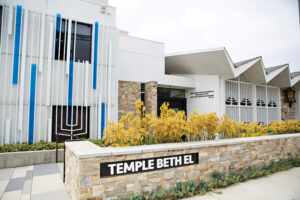
Temple Beth El’s exterior on 7th Street today. (photo: John Mattera Photography)
On August 21, in honor of Temple Beth El’s centennial, Cantor Davidson performed music from different periods over the past century in honor of the temple’s history. Fittingly, the musical celebration was in a congregant’s home, harkening back to Temple Beth El’s humble beginnings.
“In honor of our centennial, in the month leading up to the High Holy Days,” explains Rabbi Kail, “I’m inviting 29 different members of our community to share an impactful moment that they had at the temple that will go out every day as kind of a countdown to our actual centennial date, which is Rosh Hashanah. So, there are lots of really awesome things that are going on right now.” A tentative date for Temple Beth El’s 100th Anniversary Gala is Saturday, December 3, 2022.
“I want people to know that Temple Beth El San Pedro, for a hundred years, has not just been an insular Jewish community but has been a Jewish community within the greater San Pedro community, always involving itself in the betterment of our city, of our town, of our community around us,” says Cantor Davidson.
“We take our participation in those communities very seriously,” he continues. “We live our values, and if our values are to love our neighbors and to be there for each other, then that is what we do. It doesn’t matter if our neighbors are Jewish, Muslim, Christian, or Buddhist. It doesn’t matter. What matters to us is that all of our neighbors know that they are supported and loved by this community and that they are always welcome. Everyone is welcome at Temple Beth El San Pedro.” spt
For more info on Temple Beth El San Pedro, visit bethelsp.org.

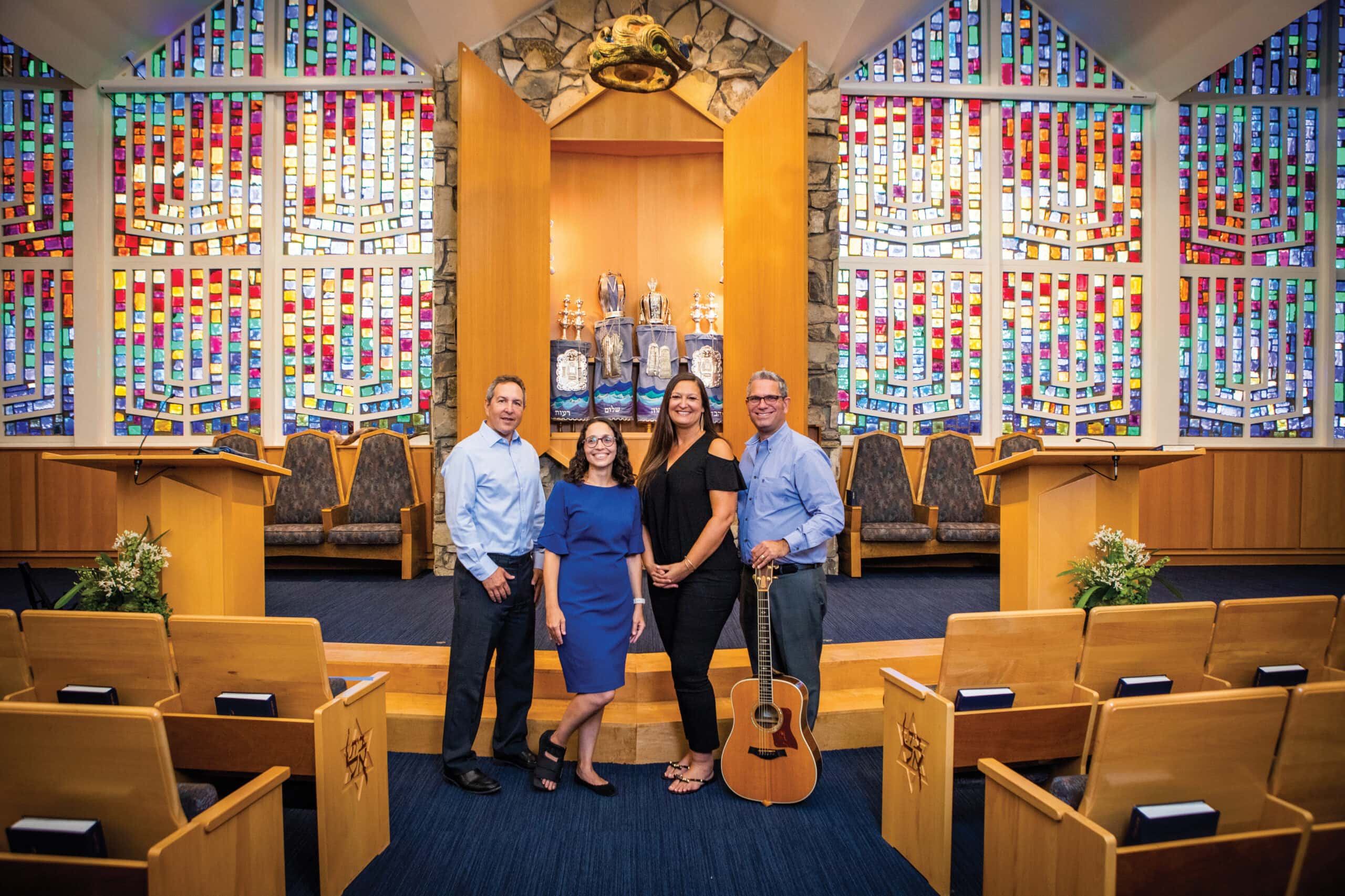
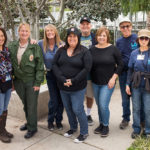
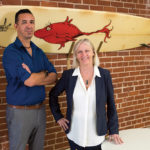

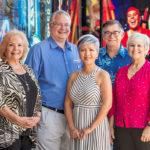
Comments